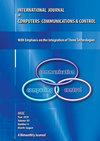Inverse Kinematics Solution for Robot Manipulator based on Neural Network under Joint Subspace
IF 1.9
4区 计算机科学
Q3 AUTOMATION & CONTROL SYSTEMS
International Journal of Computers Communications & Control
Pub Date : 2014-09-18
DOI:10.15837/ijccc.2012.3.1387
引用次数: 51
Abstract
Neural networks with their inherent learning ability have been widely applied to solve the robot manipulator inverse kinematics problems. However, there are still two open problems: (1) without knowing inverse kinematic expressions, these solutions have the difficulty of how to collect training sets, and (2) the gradient-based learning algorithms can cause a very slow training process, especially for a complex configuration, or a large set of training data. Unlike these traditional implementations, the proposed metho trains neural network in joint subspace which can be easily calculated with electromagnetism-like method. The kinematics equation and its inverse are one-to-one mapping within the subspace. Thus the constrained training sets can be easily collected by forward kinematics relations. For issue 2, this paper uses a novel learning algorithm called extreme learning machine (ELM) which randomly choose the input weights and analytically determines the output weights of the single hidden layer feedforward neural networks (SLFNs). In theory, this algorithm tends to provide the best generalization performance at extremely fast learning speed. The results show that the proposed approach has not only greatly reduced the computation time but also improved the precision.关节子空间下基于神经网络的机器人机械手运动学逆解
本文章由计算机程序翻译,如有差异,请以英文原文为准。
求助全文
约1分钟内获得全文
求助全文
来源期刊
CiteScore
5.10
自引率
7.40%
发文量
55
审稿时长
6-12 weeks
期刊介绍:
International Journal of Computers Communications & Control is directed to the international communities of scientific researchers in computers, communications and control, from the universities, research units and industry. To differentiate from other similar journals, the editorial policy of IJCCC encourages the submission of original scientific papers that focus on the integration of the 3 "C" (Computing, Communications, Control).
In particular, the following topics are expected to be addressed by authors:
(1) Integrated solutions in computer-based control and communications;
(2) Computational intelligence methods & Soft computing (with particular emphasis on fuzzy logic-based methods, computing with words, ANN, evolutionary computing, collective/swarm intelligence);
(3) Advanced decision support systems (with particular emphasis on the usage of combined solvers and/or web technologies).

 求助内容:
求助内容: 应助结果提醒方式:
应助结果提醒方式:


